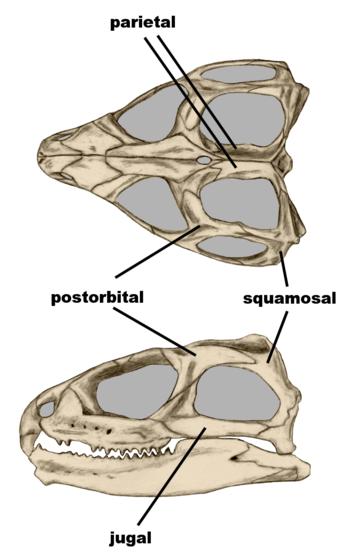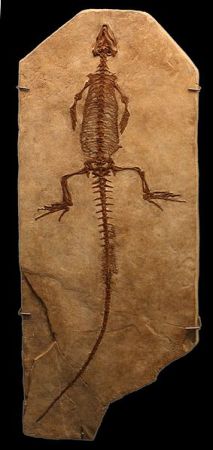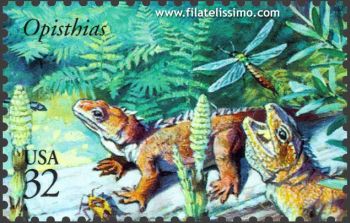Sphenodontia: Sphenodontinae
Taxa on This Page
- Cynosphenodon X
- Eilenodontini X
- Kallimodon X
- Opisthias X
- Opisthodontia X
- Sapheosaurini X
- Sapheosaurus X
- Sphenodon
- Sphenodontinae
- Sphenodontini

Sphenodon skull, with selected bones marked, from The Lépidosauriens - Rhynchocephalia (in French)
The unspecialised, akinetic skull is little changed from ancestral forms, the main distinguishing feature being the narrower parietals (the bar along the top of the skull), enabling a lighter and more open structure
|
Descriptions
Sapheosaurini: Leptosaurus neptunius, Kallimodon cerinensis, Sapheosaurus thiollierei
Kimmeridgian of France and Germany.
From Gauthier et al 1988 p.26: broad upper temporal arch, elongate upper temporal fenestra, postorbital (rear, behind the eyes) region of the skull longer than the preorbital (snout, in front of eyes) region, laterally compressed caudal (tail) vertebral centra
Comments: On the basis of studies of a new species of Clevosaurus, Wu, 1994's cladogram has a linear series Homaeosaurus, Kallimodon, Sapheosaurus but no Sapheosaurini. But on the basis of detailed analysis of another species of the ubiquitous Clevosaurus, Arantes et al 2009 confirmed the clade for Kallimodon + Sapheosaurus, as well as confirming Wu, 1994's monophyletic Clevosaurs.
Kallimodon:
Kimmeridgian of France and Germany
 |
| Sapheosaurus thiollierei Musée d'histoire naturelle de Bruxelles, Wikipedia |
Sapheosaurus:
Synonyms: Piocormus
Kimmeridgian of France and Germany.
Similar to Homoeosaurus, but skull was longer and narrower
Comments: Variously included under the suborder Homoeosauria and the family Sapheosauridae From Wikipedia: Sapheosaurus laticeps differed from Sapheosaurus thiollierei by its smaller size and more vertebrae. S. thiollierei had 22 back and neck vertebrae, while S. laticeps had 26. Also, the two differ in relative limb length.
 Sphenodontinae: Cynosphenodon, Eilenodon, Sphenodon, Zapatadon. Probably: Sphenodon > Eilenodon. However, it may be more useful (and is used here) as Sphenodon + Eilenodon + ??, or all Sphenodontians closer to Sphenodon than to Homoeosaurus, Sapheosaurus, and other similar forms.
Sphenodontinae: Cynosphenodon, Eilenodon, Sphenodon, Zapatadon. Probably: Sphenodon > Eilenodon. However, it may be more useful (and is used here) as Sphenodon + Eilenodon + ??, or all Sphenodontians closer to Sphenodon than to Homoeosaurus, Sapheosaurus, and other similar forms.
from the Early Jurassic. 2 (3?) living species of Sphenodon; fossorial, live in association with sea birds on islands off New Zealand.
Characters: Sphenodon is the giant of this largely diminutive group. Generally triangular, teeth with round cross-section; teeth added from posterior of jaw; $ caniniform teeth posterior to edentulous ridge at anterior end of dentary; $ proplinal jaw movement, as judged from wear facets on teeth; prominent coronoid process of dentary; dentary markedly straight ventrally, with small, ventral "chin" projection under symphysial area; retroarticular process reduced; central region of pterygoid long; lower temporal fenestra small <25% skull length); posterior process of ischium present.
References: Reynoso 1996); Reynoso (1997); Reynoso & Clark (1998).
Image: Sphenodon punctatus. tuatara. ATW040220.
Sphenodontini: Cynosphenodon, Sphenodon
Middle Jurassic to Recent.
Middle Jurassic of Mexico; Recent, islands off New Zealand.
propalinal jaw action, anterior caniniform tooth on jaw and dentary (Reynoso 2000)
Cynosphenodon:
Middle Jurassic of Mexico.
Sphenodon: the Tuatara
Recent, islands off New Zealand.
From Zittel/Eastman/Woodward 1902 (copyright expired): "Inferior border of the large orbits formed by maxilla external nares divided ; a single tooth on either side of the premaxillary beak; intercentra present between all the vertebrae, humerus with both entepicondylar and ectepicondylar foramina or grooves."
Links: Wikipedia - Tuatara, and many other links
Opisthodontia:
Late Jurassic to Cretaceous of North and South America
Comments: This name has also been given to a genus of moth of the family in the family Lasiocampidae.

Opisthias: Opisthias rarus Gilmore, 1909
Late Jurassic (Late Kimmeridgian-Early Tithonian) the Morrison Formation of western North America,
Comments: known only from lower jaws, had Sphenodon-like teeth and a propalinal (front-to-back motion) jaw action (Benton 1985 p.149)
Links: The World of Dinosaurs - Stamps (see illustration at right)
Eilenodontini: Ankylosphenodon, Eilenodon, Priosphenodon, Toxolophosaurus
Known from the Late Jurassic to Cretaceous of North and South America
propalinal jaw action, deep mandible, retroarticular process reduced, marginal teeth expanded mediolaterally (Reynoso 2000)
Comments: A diverse assemblage of Jurassic and Cretaceous forms. Eilenodon and Toxolophosaurus were deep-jawed forms with very wide grinding teeth, indicating a herbivorous diet. Priosphenodon reached a metre in length, the largest known sphenodontian. The aquatic Ankylosphenodon is included here but may have a more basal position, if so this group would be known from North America only
References: Benton 1985 p.149, Reynoso 2000, Apesteguía & Novas 2003
Using this material. All material by ATW is public domain and may be freely used in any way (also any material jointly written by ATW and MAK). All material by MAK is licensed Creative Commons Attribution License Version 3.0, and may be freely used provided acknowedgement is given. All Wikipedia material is either Gnu Open Source or Creative Commons (see original Wikipedia page for details). Other graphics are copyright their respective owners



